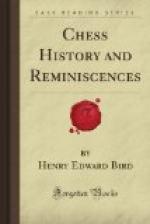STEINITZ’S REVIEW
The Field, December, 1879.
Chess openings, 1879.
The Chess Opening, Considered Critically and Practically.
By H. E. Bird.
London: Dean & Son, 160, Fleet Street.
The public record of chess matches and great tournaments places the name of the author of this work above that of any living English competitor for chess honours, excepting Mr. Blackburne. It is therefore all the more disappointing to find that Mr. Bird’s book has not done justice to his great reputation as a player. The author’s chief defect as an analyst arises probably from one of his distinguishing qualities as a practitioner over the board. Few chess masters could excel Mr. Bird in rapid survey of position and in the formation and execution of surprising maneuvers, which, though not always sound—and sometimes, as he admits, even eccentric—tend to raise confusing complications, difficult for the adversary to disentangle at a quick rate. These qualities make Mr. Bird one of the most dangerous opponents in “skittle play,” or in matches regulated by a fast time limit; but they prove almost antagonistic to the acquirement of excellency as an author on the game. For the first-class analyst is not merely expected to record results, but to judge the causes of success or failure from the strictly scientific point of view, and he has often to supplement with patient research the shortcomings of great masters in actual play. In such cases every move of a main variation becomes a problem which has to be studied for a great length of time; and the best authors have watched the progress of different openings in matches and tournaments for years, and pronounced their judgment only after the most careful comparisons, Mr. Bird is, however, too much of an advocate to be a good judge, and he evinces great partiality for ingenious traps and seductive combinations, which form an attractive feature of his own style in actual play, but which mostly occur only in light skirmishes. Moreover he often treats his duties as an analyst in a cavalier fashion. In his quotations from other authors he embodies variations which stand already severely condemned by first-class chess critics in various chess periodicals; and his original researches contain a considerable portion of “skittle” analysis, which does not bear cursory examination.
We have no room for lengthened demonstrations, and must confine ourselves to a few instances of the latter description, all occurring in the compiler’s new additions. On page 6, he overlooks the winning of a clear piece which White can effect by Q to R4, followed by P to QR3 if the B be defended. On page 22 Black can win a piece on the 16th move by P to KB4, followed by P to KKt3, and there is no chance of any counter-attack by P to KKt4, for Black may afterwards interpose the B at K4, and get the K into the corner. On page 105 a piece can be won by




